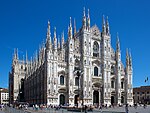Death and state funeral of Silvio Berlusconi
2020s in MilanAll pages needing factual verificationDeaths and funerals of politiciansDeaths by person in ItalyEngvarB from June 2023 ... and 4 more
Events in MilanJune 2023 events in ItalySilvio BerlusconiState funerals in Italy

On 12 June 2023, former Italian prime minister Silvio Berlusconi died at the San Raffaele Hospital in Milan, aged 86, due to complications from a severe form of chronic myelomonocytic leukaemia. On the same day, the Italian government announced a state funeral and proclaimed a national day of mourning for 14 June.
Excerpt from the Wikipedia article Death and state funeral of Silvio Berlusconi (License: CC BY-SA 3.0, Authors, Images).Death and state funeral of Silvio Berlusconi
1_33051, Milan Municipio 1
Geographical coordinates (GPS) Address Phone number Website Nearby Places Show on map
Geographical coordinates (GPS)
| Latitude | Longitude |
|---|---|
| N 45.464166666667 ° | E 9.1913888888889 ° |
Address
Duomo di Milano
1_33051
20122 Milan, Municipio 1
Lombardy, Italy
Open on Google Maps









